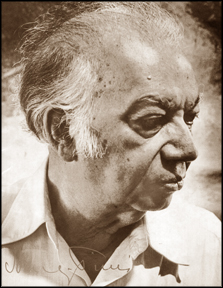|
Harry Pieris:
Life dedicated to art
by Tissa HEWAVITARANE
Never was a period in the life of a nation better suited to the brush
of an artist than the 19 th century in Sri Lanka. To be sure, Harry
Pieris had been a master artist. He was born on August 10, 1904 as the
son of an extremely wealthy land-owner. He shared the aspirations of his
contemporary socialist friends.
 Pieris was an Oxford graduate with degrees in Pali and Sanskrit. He
was the translator of Kalidasa's epic poem, the 'Seasons'. At the age of
13 he was trained in the art of painting for six years under Gate
Mudaliyar A.C.G.S. Amarasekera a pioneer art teacher and a painter of
international repute. After teaching him for six years, Mudaliyar
Amarasekera asked Harry's mother to send him abroad. Pieris was an Oxford graduate with degrees in Pali and Sanskrit. He
was the translator of Kalidasa's epic poem, the 'Seasons'. At the age of
13 he was trained in the art of painting for six years under Gate
Mudaliyar A.C.G.S. Amarasekera a pioneer art teacher and a painter of
international repute. After teaching him for six years, Mudaliyar
Amarasekera asked Harry's mother to send him abroad.
Coming from a affluent family background the art was certainly not
considered a suitable profession. Of course, Harry wanted to paint
portraits of people, unheared of in his rather conservative family.
Painters in those days were looked down upon as inferior creatures.
There began in his soul a violent struggle between beauty and duty,
between the ideas of the old world and the ideals of the new. But after
some time Harry was able to pack his bags to proceed to England. While
in London he was admitted to the Royal College of Arts by Sir William
Rothenstein who was its principal. Sir Rothenstein took a keen interest
in Harry since he was the first Sri Lankan to be admitted. After a
period of three years he obtained the Diploma in Art from the Royal
College of Art in 1927. Shortly afterwards he went to Paris where he
took private lessons from a Russian Jew called Robert Folk who was an
excellent teacher. He explained to Harry the finer points of the work of
old masters. In Paris he worked at the Atlier de Grande Chaumiore
Gallery until he left France in 1935.
But it was Sir William Rothenstein again who influenced his decision
to go to India and join Shantiniketan.
He was admitted to Shantiniketan where he stayed for two and half
years and acquainted himself with the beauties of Indian art. It was in
India that he really discovered himself as an artist, after seeing the
cave paintings of Ajanta. His work was influenced the style of Ajanta
paintings and his pallette was a combination of Indian red, yellow
ochre, terriverte, and carulean blue. He made a careful study of the
cave paintings. He remained, however, a genuinely Sri Lankan painter as
much in his subject matter, pallette and mood as in the authenticity of
his technique and feeling. In 1953 Harry Pieris was invited by the
American embassy to visit the United States on a Smith Mundt Leadership
Grant in recognition of the work he was doing to help other artists in
Sri Lanka. One of his close artistic associates during this time was
Rumanian woman painter, Madame Popesco Harry and did a number of pencil
drawings of her and a study of these pictures shows the finesse of his
draughtsmanship quality which underlines all his later work.
Harry Pieris is widely known as a portrait painter. But few seems to
know that he has painted some fine landscapes. Having proved his mastery
of the genre painting and the wood cut, he was able to arouse the
enthusiasm of the affluent wealthy Colombo 7 women. This was all the
more surprising because he never flattered any of his clients. He
painted them as they were, in all their physical imperfection and with
all their moral shortcomings and beauty. He was able to use his brush,
without hindrance and to good purpose. His used of soft and glowing
colour was remarkable. He wielded his brush, to the delight of his own
generation and to the enrichment of the generations to come. He will be
remembered too for his many landscapes of a brooding and evocative
charm.
There were no barriers for Harry between East and West or people of
different backgrounds. He was a guiding force and a leading organiser
for young artists, while recognising new talent and unearthing young
artists all the time. He devoted his time to his consuming passions in
arts.
Harry Pieris returned to Sri Lanka in 1938 where already there was
significant artistic activity and formed the '43 group in 1943, which
made an indelible impression on our artistic development.
In 1983 Harry Pieris had a stroke that left him paralysed. His life
spanned eighty years and he died on March 14, 1988.
As a founder member and secretary of the '43 group he gave much of
his time to organising the group exhibitions. Today his home at Barnes
Place is a gallery of modern Sri Lankan art open to anyone interested in
art. Periodically, important exhibitions are held in his gallery. A
completely unselfish person he has left his wealth, and a fine
collection of about 70 to 80 paintings to the Sapumal Foundation. Thus
both within and beyond the 43 group he has had and will continue to have
an enormous influence on the younger painters of Sri Lankan art.
www.tissahewavitarane.com |

